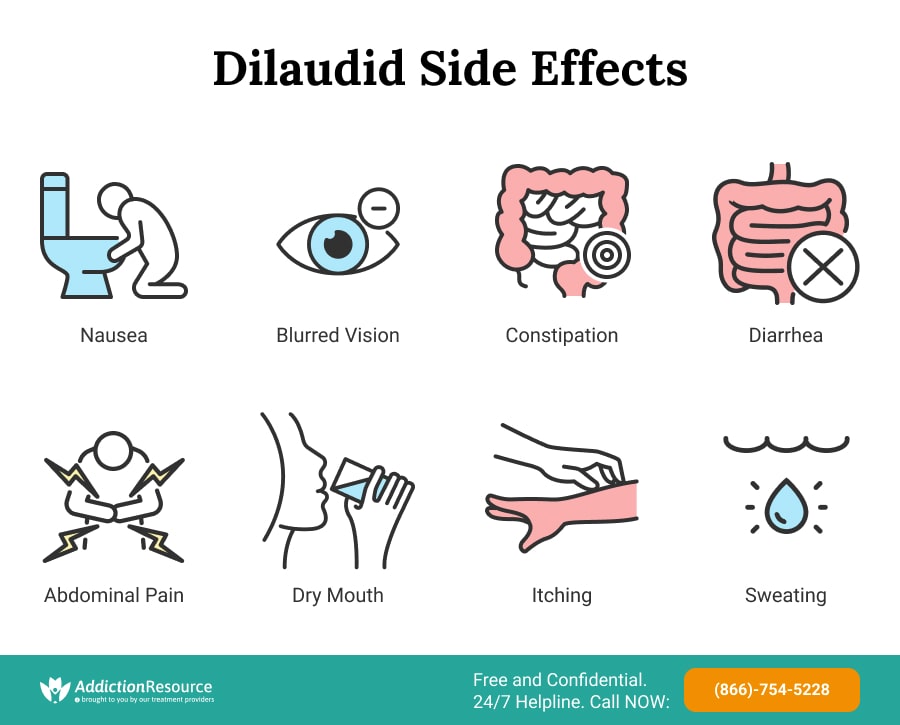Hydromorphone is a pain reliever. However, it’s different from regular over-the-counter pain-relieving medication as it is an opioid. It is prescribed to people who have already taken pain relievers repeatedly and have become tolerant to common pain relievers. These are also for people that need constant pain relief, as this is one of the drugs that can be taken around the clock.
Table Of Contents:
The people prescribed with Hydromorphone must have all the necessary information, and they need to make sure they don’t suffer hydromorphone side effects. If they do and their condition seems to be worsening, they should know what to do. For that, they need to know precisely all the information about hydromorphone side effects, allergy, overdose possibilities, and the safe use of the medication.
Short-Term Side Effects Of Dilaudid
One of the main reasons that Hydromorphone is prescribed to people is for pain relief. It provides this relief by altering the way the brain processes pain signals. It lowers the intensity of pain receptors in the brain, so the patient ends up feeling like they aren’t in severe pain, even if they are.

When this medication is taken via the oral route, it takes around 30 minutes to work. However, if the patient is in extreme pain, an injectable version only takes about 5 minutes to kick in.
The only downside is that with its effectiveness comes a range of adverse effects too. They vary from mild to severe. In addition, some hydromorphone side effects only last a short amount of time, while others are longer lasting.
Less Severe, Short-Term Side Effects of Dilaudid Include:
- Blurred vision, double vision
- Flushing (warmth, redness, or tingly feeling)
- Nausea
- Vomiting
- Constipation
- Diarrhea
- Stomach pain
- Dizziness, drowsiness
- Dry mouth
- Sweating
- Itching
- Sleep problems (insomnia) or strange dreams
Usually, minor hydromorphone side effects do not pose a significant physical danger to one’s system. Furthermore, medical assistance is not necessary for those situations as well. However, if they persist for an extended period, doctors advise the users to seek medical help.
Long-Term Side Effects
Although the mild or short-term effects should subside on their own, sometimes the hydromorphone side effects can be a lot worse. Long-term or severe side effects of Dilaudid can occur in anyone. It can happen either as a reaction to the medication or simply because too much has been consumed in a short period. These can be more dangerous than the mild ones that have already been described, and the risk for it is always imminent. If the patient experiences any severe symptoms, it’s vital that they are monitored and that their doctor is informed immediately to ensure that the symptoms don’t become life-threatening.
Here Are a Few Of the Symptoms One May Experience:
- Shallow, weak, or very slow breathing
- Trouble breathing
- Slow heart rate
- Confusion
- Lightheadedness or fainting seizures (convulsions)
- Seizures (convulsions)
- Cold, clammy skin
- Pounding heartbeats or fluttering in the chest
- Wheezing
- Confusion
- Severe weakness or drowsiness
It’s crucial to address the more severe Dilaudid side effects right away. Therefore, if one notices any of the symptoms mentioned above, do not hesitate to call the doctor.
Apart from the physical effects like nausea or confusion, the patient might even experience adverse mental effects while taking Hydromorphone, whether they take it oral or via injection. These could be anything from moderate to severe mood changes, being very irritable, getting easily agitated, being confused, to experiencing hallucinations. These might not be very easy to spot because they can mask themselves under common everyday problems. Still, if the patient has the correct information about the Dilaudid side effects, it’s far more likely that they will notice if the changes in their mental state have something to do with the drug use. If it does, they should call their doctor immediately to alter the dose.
Dangers of Snorting
Snorting Dilaudid is considered to be highly dangerous. The faster the medication enters a user’s body, the more likely he or she will become addicted, and snorting Dilaudid has the most rapid effect. The drug enters the blood faster than in pill form or through injection, and a higher percentage comes into contact with the blood-brain barrier. Therefore, snorting Dilaudid is more likely to cause a hydromorphone overdose than consuming it as a pill or via injections.
Physical Dangers of Snorting Dilaudid:
- Brain damage
- Damage to the cartilage of the nasal passages
- Hypoxia (decrease of blood flow to the brain)
- Drug overdose
- Facial damage
Dilaudid Allergy
Along with the short-term and long-term Dilaudid side effects, it can also cause an allergic reaction. This could cause the patient to have Dilaudid allergy symptoms such as slowed or extreme trouble in breathing, their tongue, face, or throat could swell up, which could further cause breathing problems, they could break out in hives or a rash.

If any of these symptoms appear, contact a doctor immediately or rush to an emergency room for immediate medical treatment.
Precautions To Know Before Taking Hydromorphone
Since Hydromorphone is an opioid, it’s important that the patient takes it knowing how it may interact with other drugs. Having the correct information can save their life.
Hydromorphone can interact with such drugs as benzodiazepines, general anesthetics, Prochlorperazine, monoamine oxidase inhibitors (MAOIs). It is integral that the patients have informed their medical doctor about any other kind of oral or injectable drugs they might be taking to ensure that nothing can interact with the opioid to cause Dilaudid adverse effects. If the interaction is severe, it could lead to severe health effects like a coma or death.
It is also important that the patients inform the doctor if they’re pregnant or are breastfeeding, have any existing respiratory problems, deal with low blood pressure or struggle with urinary tract infections, or problems with bowel movements. All of these can be affected by the medication as well.
Finally, since Hydromorphone can make people sleepy, drowsy, or less alert, mixing the opioid with alcohol can significantly worsen the Dilaudid adverse effects. If the patient tends to drink a lot, they need to notify their medical doctor before taking it. It is advised not to mix the two at all to avoid life-threatening conditions.
Hydromorphone Overdose
Hydromorphone is a potent drug. Comparing Dilaudid and Morphine, for example, the first is around five times more potent. So it must be taken with care because an overdose can happen if the wrong amount is taken, and the patient’s health can deteriorate very quickly. That is why the FDA warns against taking this opioid without having a proper measuring device. It’s specifically advised not to use something like a household spoon because it can lead to an inaccurate dose of the medication every time. Whether the patients are taking the drug orally or via an injection, a calibrated device should be used to measure the amount of this drug. Extreme care is used while taking it to ensure the correct dose. Failure to do so may lead to an overdose.
A 2017 case study showed that overdoses could be avoided if the correct dose was given. Inaccurate measurement led to almost all of the overdoses in the study.
The Signs That Show That a Person Has Hydromorphone Overdose Are the Following:
- Lips and fingernails turning into a bluish color
- Hypotension
- Dizziness
- Slow, shallow breathing
- Weak pulse
- Stomach spasms and muscle twitching
- Slowed heart rate
- Dilated, unresponsive pupils indicate brain injury from lack of oxygen.
All in all, it’s not unusual that Hydromorphone overdose leads to more severe complications such as coma or death. That is why it is important to react right away when some of these symptoms are noticed. Overall, when respiratory pathways are at stake, every second counts.
Dilaudid Overdose Treatment
After admitting a person who has overdosed to a hospital, doctors may use different methods to cut the drug’s impact. The most common procedure is to give the patient activated charcoal. They use charcoal to prevent the body from absorbing more of the drugs. A stomach pump may also be used to remove the drug from the body.

Depending on the time passed after the overdose, recovery is possible after a few hours. But in more severe cases, the process may take longer. Thus, withdrawal symptoms may begin within hours after the last dose. It may persist for several days, even weeks.
Many people seek help in detox programs, support groups, and medical interventions.
The Safety of Dilaudid
Dilaudid is a drug that can be of great help to people dealing with severe long-term pain. It is safe for their health to take it as long as the patients and their caregivers know the drug’s accurate information. The dose, the potential effects on the person’s mental health, possible Dilaudid allergy reactions, and the possibility of an overdose are all important and need to be considered. Taking care every step of the way and alerting their medical doctor any time something concerning happens is the key to making sure that drugs like these end up being safe to take for the patient’s health. It is also important that even if they experience an overdose, they know exactly who to call, where to go, and how to get medical treatment. Having all of the right information makes taking this drug as safe as possible for the patient’s health.
Addiction to Hydromorphone shouldn’t be treated without proper medical assistance. Find and choose a rehab facility to start the recovery process.
Hope Without Commitment
Find the best treatment options. Call our free and confidential helpline
Most private insurances accepted
Page Sources
- Abi-Aad, K. R., & Derian, A. (2019). Hydromorphone. StatPearls [Internet]. https://www.ncbi.nlm.nih.gov/books/NBK470393/
- Lee, S. H., Lee, C. J., Kim, T. H., Shin, B. S., Lee, S. Y., Joo, E. Y., & Sim, W. S. (2011). Novel Use of Hydromorphone as a Pretreatment Agent: A Double-blind, Randomized, Controlled Study in Adult Korean Surgical Patients. Current therapeutic research, clinical and experimental, 72(1), 36–48. https://pubmed.ncbi.nlm.nih.gov/24648574/
- Healthdirect Australia, https://www.healthdirect.gov.au/hydromorphone#risks
- Medlineplus, Hydromorphone Drug Information, https://medlineplus.gov/druginfo/meds/a682013.html
- U.S. Food and Drug Administration, Hydromorphone Label, https://www.accessdata.fda.gov/drugsatfda_docs/label/2016/019891s024,019892s029lbl.pdf
- Lowe, A., Hamilton, M., Greenall BScPhm MHSc, J., Ma, J., Dhalla, I., & Persaud, N. (2017). Fatal overdoses involving hydromorphone and morphine among inpatients: a case series. CMAJ open, 5(1), E184–E189. https://www.ncbi.nlm.nih.gov/pmc/articles/PMC5378545/

 Authored by
Authored by  Reviewed by
Reviewed by 